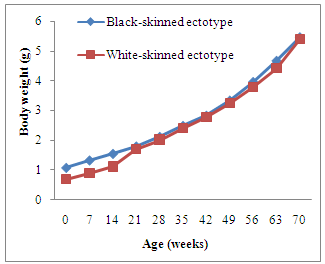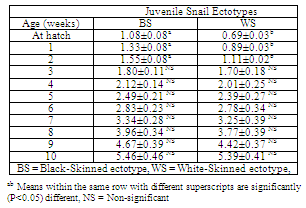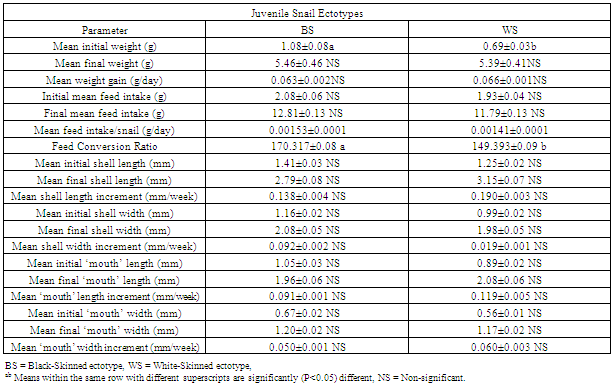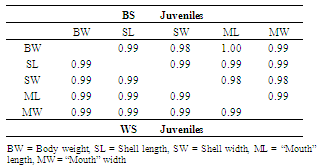-
Paper Information
- Next Paper
- Previous Paper
- Paper Submission
-
Journal Information
- About This Journal
- Editorial Board
- Current Issue
- Archive
- Author Guidelines
- Contact Us
International Journal of Agriculture and Forestry
p-ISSN: 2165-882X e-ISSN: 2165-8846
2012; 2(4): 145-149
doi: 10.5923/j.ijaf.20120204.02
Evaluation of Growth and Correlations Between Body Weight and Shell Measurements of the Juveniles of Two Ectotypes of Archachatina Marginata var. Saturalis (P) Snail
Ibom L. A. , Okon B.
Department of Animal Science, University of Calabar, Calabar, (540004), Nigeria
Correspondence to: Ibom L. A. , Department of Animal Science, University of Calabar, Calabar, (540004), Nigeria.
| Email: |  |
Copyright © 2012 Scientific & Academic Publishing. All Rights Reserved.
This study provides information on the growth and correlations between body traits of juveniles of two ectotypes of snail[Archachatina marginata var. saturalis (P)]. Three hundred juveniles, one hundred and fifty each of the black-skinned (BS) and white-skinned (WS) ectotypes selected from a pool on the basis of active appearance and absence of injury, blister or lesion on the foot and/or shell were used for the study. The selected juveniles were grouped into two on the basis of skin (foot) colour. Each group was replicated five times with ten juveniles per group in a completely randomized design. The results of this study showed that during the juvenile phase of growth, there was progressive weight increment with significant differences (P<0.05) between the juveniles of the two snail ectotypes (BS and WS) at hatch through to week two after hatch. The significant difference seized to exist after week two as growth was at par among the ectotypes. The absence of significant difference (P>0.05) after week two could mean that irrespective of their pigmentation and weight at hatch, juveniles of a particular breed always grow to catch up with others within the same environment. The results also showed that growth in terms of weight gain was generally low/slow during the first few weeks of life after hatch. The reason for this could be that the juveniles eat little or no feed (concentrate and/or forage) during this stage of life. The results of estimates of association between traits showed that all evaluated traits had strong positive correlations in the two snail ectotypes studied. The correlations between these traits were highly significant (P<0.001). The positive correlation values recorded among these traits could mean that the traits are influenced by the same genes in the same direction, and that there are direct relationships between the traits. Besides, it could be that weight increment in snails is as a result of increase in the size of corresponding traits. The high degree of correlation among traits indicates that selection for one trait will lead to improvement in the other trait. The results of this study could guide breeders in the development of stocks, and thus increase the availability of animal protein for the teeming Nigerian populace.
Keywords: Correlations, Ectotypes, Growth, Juveniles, Snail
1. Introduction
- Body weight is the growth parameter used to measure growth rate in animals. Reference[1] stated that growth in terms of body weight gain is the most widely used growth index from birth to maturity. Reference[2] however reported that the weight of a juvenile snail at hatch is the first indicator of hatchling’s growth rate and is useful as a starting point for measuring subsequent growth. The author further stated that body parameters (shell length, shell width and shell thickness) and aperture (shell “mouth”) parameters indices that can be taken at hatch and used to measure subsequent snail growth and growth rate. Growth rate according to[3] is measured as the increase in body weight overtime and is largely dependent on the amount of nutrient supply, coupled with the specific tissue. According to[4], change in body weight relative to the initialweight of an animal is referred to as growth rate. The authors further stated that growth rate is influenced by such factors as genetics, nutrition, disease and hormone. Reference[5] stated that body weight has been used by both local sellers/buyers and researchers as a parameter for selection. Besides,[6] reported that growth rate in giant land snails, Archachatina marginata and Achatina achatina has generated interest among Nigerian researchers as farmers demand recipes for raising snails to market weight in less time.The juvenile phase (1 – 2 months) of snail to sexual maturity (14– 20 months) is the phase during which very rapid growth takes place in snails[7]. The growth rate of snails varies considerably between individuals in each population group. In the same vain,[7] reported that snails show differences in growth rates.Weight gain and shell growth correlate positively with feed intake in snails[8,9]. The body traits of snails that can be used in the assessment of growth rate are the phenotypic qualities, especially the shell that is readily seen[2]. This can be measured in terms of length, width and thickness, the author added. Reference[9] reported that snail shell increases as the body size increases and that the shell makes up 30 – 40 % of the whole body by weight.Reference[10,11] reported highly significant positive correlations among the morphometric traits of F1 crossbred and albino (white-skinned) snail hatchlings (A. marginata var. saturalis). A correlation between body weight and shell measurements can serve as important factor in marketing, and breeders can use it as a guide to improve market value or the quality of breeding stocks. This study was therefore intended to provide valuable information for the improvement of stock by breeders.
2. Materials and Methods
- The study was conducted at the Snailery Unit, Department of Animal Science Teaching and Research Farm, Cross River University of Technology, Obubra Campus, Nigeria. The study area and climate of Obubra have been described previously[2,12,13].Three hundred juveniles, one hundred and fifty each of the black-skinned and white-skinned (albino) ectotypes were selected at hatch from a pool produced by black-skinned x black-skinned and white-skinned x white-skinned parent snails and used for the experiment. The juveniles were selected based on active appearance and absence of injury, blister or lesion on the foot and/or shell. Selected juveniles were then grouped into two treatments on the basis of skin (foot) colour. Each treatment was replicated five times with ten juveniles per treatment in a completely randomized design. They were managed in a cell measuring 40 sq. cm by 30 cm depth. The cell compartments in which the snails were managed were kept under trees shed throughout the three months (May – July) duration of the experiment. This was during the rainy season in Nigeria.The experimental juveniles were fed on a mixed feeding regime of forage (pawpaw leaves) supplemented with formulated diet. The formulated diet contained 24 % CP, 2650 % ME and 15 % Ca. Maize, soybean meal, fish meal, bone meal, oyster shell and vit./min. premix. were the ingredients used in formulating the diet. Feed and water were given unrestricted throughout the study period.Data were collected on growth and body parameters of the juveniles. The growth traits assessed included body weight, weight gain, feed intake and feed conversion ratio; while the body parameters were shell length and shell width. Also, the juveniles’ aperture (shell “mouth”) traits, length and width were assessed. These traits were measured at hatch and weekly thereafter using electronic scale having 0.01 g sensitivity for body weight and Vernier Caliper for other traits. Body weight gain was obtained by difference of present week weight from the previous week weight. Feed intake was measured daily by difference between quantity of feed served and quantity leftover after 24 hours while feed conversion ratio was calculated as the ratio of feed intake to weight gain.Data collected were analyzed using the “Student” t – test statistical tool as modified by[14]. Where significant differences existed, means were separated using the Least Significant Difference (LSD) of the same modification. Association between the phenotypic traits (body weight, shell length, shell width, shell thickness, aperture length and aperture width) was determined using the Simple Pearson’s correlation Module according to[15].
3. Results and Discussion
- The results of mean weekly body weight of juvenile snails obtained in this study are presented on Table 1.The results showed that at hatch through to week two after hatch, there was significant difference (P<0.05) in weight between the juvenile snail[black-skinned (BS) and the white-skinned (WS)] ectotypes. However, no significant difference (P>0.05) was expressed by the two snail ectotypes for this trait in other weeks of growth during the juvenile phase. The absence of significant difference could reveal that irrespective of their pigmentation and weight at hatch, juveniles of a particular breed always grow to catch up with others within the same environment. The results also showed that growth in terms of weight gain is generally low/slow during the first few weeks of life after hatch. The reason for this as advanced by[2] is that the juveniles eat little or no feed (concentrate and/or forage) during this stage of life. The author further stated that their survival depends largely on body reserves (residual yolk, glycogen and muscle protein), egg content leftover and soil as they harden up and become familiar with the new environment outside the egg shell or embryonic environment. The slow rate of weight gain could also be attributed to the non-provision of maternal protection by parent snails to their babies (juveniles). A progressive weight increment was observed among the ectotypes during the juvenile phase (week one to ten). The progressive weight increment obtained in this study is conventional as there is always increase in body weight at different ages in different groups of animals. The progressive increase in body weight is in agreement with the reports of[16,17]. Table 1 also showed that when the juveniles are fully accustomed to the natural environment, they gain weight substantially, perhaps because they now consume appreciable quantity of feed. The mean body weights of juveniles obtained in this study for both strains (BS and WS) were lower than the values of 2.1 – 2.5 g and 2 – 7 g reported by[9,18-20] respectively for black-skinned A. marginata. However, the mean weight of juveniles at hatch for this study is within the range of 0.66 – 0.93 g, 0.69 – 1.42 g and 0.71 – 1.19 g reported by[21-23] respectively for white-skinned, black-skinned and albino (white-skinned) strains of A. marginata. The mean weight of juveniles at hatch for this study (Table 1) is higher than the value of 0.09 – 0.13 g range reported by[24] for A. marginata. The differences in juveniles’ weights at hatch may be attributed to differences in sizes of parent snails used in the respective studies since juveniles’ size at hatch correlates positively with the size of the parent snail. This assertion corroborates[25] who established that the size of baby snails at hatch correlates positively with the size of their parents. From the foregoing, it could be right to infer that there exist distinct biological relationships between the weight of juveniles at hatch and that of the parent snails.
|
 | Figure 1. Growth performance of juvenile snails |
|
|
4. Conclusions
- The results of this study showed that during the juvenile phase of growth, there was progressive weight increment with significant differences (P<0.05) between the juveniles of the two snail ectotypes (BS and WS) at hatch through to week two after hatch. The significant difference seized to exist after week two as growth was at par among the ectotypes. The results of correlations among traits showed variations between the ectotypes. However, the results indicated that improvement of traits is possible if selection is applied. The results of this study could guide breeders in the development of stocks, thus increasing the availability of animal protein and contribute positively to food security.
 Abstract
Abstract Reference
Reference Full-Text PDF
Full-Text PDF Full-Text HTML
Full-Text HTML

